



Zweigelt 2017 red 11% dry unfiltered

Emese’s dream
In accordance with tradition, she is recognized as the progenitor of the Hungarian royal lineage, originating from one of the seven original Hungarian tribes. Consequently, she is hailed as “the ancestress of all ethnic Hungarians.”
Emese’s Vision, the ancient narrative concerning the conception of Prince Álmos, represents one of the earliest recorded tales in Hungarian history. The origins of this legend can be tentatively traced back to the period around 860-870 AD, and with certainty, it falls within the range of 820 to 997 AD (spanning the birth of Álmos and the embrace of Christianity).
In this legend, Emese, the spouse of Chief Ögyek (Ügek), underwent impregnation by a mythical Turul bird. The Turul materialized in her dream, conveying a prophecy that a majestic river would emerge from her womb, flowing across unfamiliar territories. Interpretations of this dream indicated the birth of a son who would guide his people away from their home in Levedia, ultimately becoming illustrious monarchs. Emese’s son was christened Álmos, a name deriving from the Hungarian word “álom,” meaning dream; thus, “Álmos” can be construed as “the Dreamer.”
Variations of the legend exist, particularly concerning whether Emese was impregnated by the Turul bird or whether she was already pregnant when she had the dream. Additionally, there are discrepancies as to whether the bird physically manifested or appeared to her solely within the realm of dreams while she slumbered.
Cabernet Franc 2019 red 12% dry unfiltered
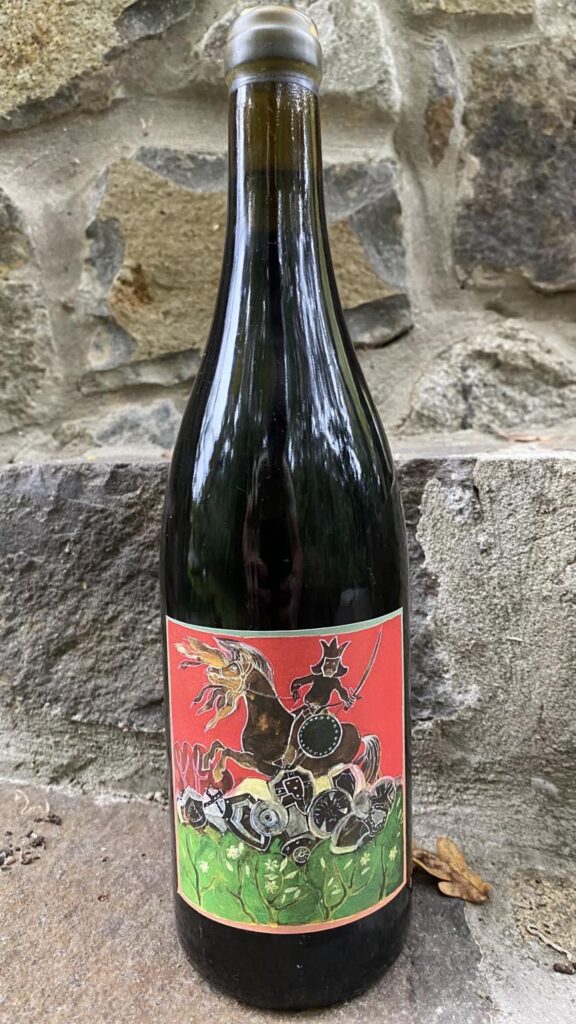
Legend of Vertes
The Battle of Vértes (Hungarian: Vértesi csata) occurred in 1051 as a conflict between Emperor Henry III and King Andrew I of Hungary. Emperor Henry III initiated an invasion of Hungary in pursuit of his lost estate, leading to this historical clash.
In this campaign, the German forces employed a dual-pronged approach. One group crossed the Vág River and advanced as far as the Nitra River, breaching the western border gate known as the Bufferzone (Hungarian: Gyepű) of Moson-Sopron, entering Transdanubia from Styria. Bishop Gebhard of Regensburg led the other army, securing control of the Danube River to facilitate supply transportation.
The Hungarian strategy involved the use of scorched-earth tactics against the imperial troops, akin to what Stephen had done against Conrad II in 1030. The local population was evacuated, and food supplies were confiscated or destroyed. Nevertheless, the German forces managed to reach the Vértes Hills and, according to some accounts, even Székesfehérvár. Starvation plagued the Germans as they struggled to find sustenance, while they faced frequent skirmishes with the Hungarians. Hungarian horse archers harassed the Germans at night, launching hit-and-run attacks.
Eventually, the Germans decided to abandon the Vértes Hills and head north to their supply ships. However, Duke Béla had intercepted one of their couriers, prompting a message to be sent to the bishop on behalf of the Germans, declaring the end of the campaign and ordering their return to Regensburg.
Emperor Henry’s hopes of relief from the ships were dashed, and his army was starving. They suffered greatly from Hungarian and Pecheneg attacks during the night, enduring poisoned arrows and disruptive tactics. Faced with dire circumstances, the German emperor had no choice but to seek peace.
In a display of generosity, King András I of Hungary sent fifty large cattle as well as two thousand units of bacon, a thousand oxen, ample bread, sheep, and an abundance of wine to aid the starving enemy. Overjoyed by their deliverance, the German soldiers hastily departed, leaving their equipment and discarding their shields and weapons. The hillsides were said to be stained with blood, and a legend documented in medieval Hungarian chronicles claims that the Vértes mountains were named in memory of this event. Consequently, to this day, the mountain range is referred to as Vértes, with “vért” being the Hungarian word for armor.
Pinot Noir 2021 red 12,5% dry unfiltered

legend of The Tree of Life
In a remote Hungarian village lived a family named Kálmán. The Kálmáns were known for their ancient apple tree that stood in their garden, referred to as “Az élet fa legenda” or “The Tree of Life.”
The legend held that this tree possessed magical powers. It was said that anyone who sat beneath its shade and quietly expressed their thoughts and wishes could make their dreams come true. The Kálmáns firmly believed in this legend and often visited the tree to share their hopes and fears with it.
Over the decades, the Kálmán family experienced many highs and lows. They experienced joyful moments, such as the birth of their children and the success of their harvest, but also sad times, like the loss of loved ones. Yet, the Tree of Life was always their refuge.
One day, a young man named Viktor stood infront of the Tree. He had come from the city and had heard of the legend. Viktor was a dreamer with big ambitions in life. He sat beneath the Tree of Life and quietly expressed his hopes.
The Kálmáns spotted Viktor and invited him into their home. They shared their stories and experiences with him. Viktor became a part of their family and helped care for the tree.
With time, Viktor’s dreams came true. He became a successful businessman but never forgot the Kálmán family and the Tree of Life that had guided him on his path.
The legend of the Tree of Life continued to be passed down from generation to generation. And so, the Kálmán family and their story, intertwined with this special tree, lived on forever in the hearts of the village’s people.
The Tree of Life was not just a tree but a symbol of dreams, hopes, and the power of community that assists us in achieving our goals and writing our legends.
Kadarka 2021 red 12,5% dry unfiltered
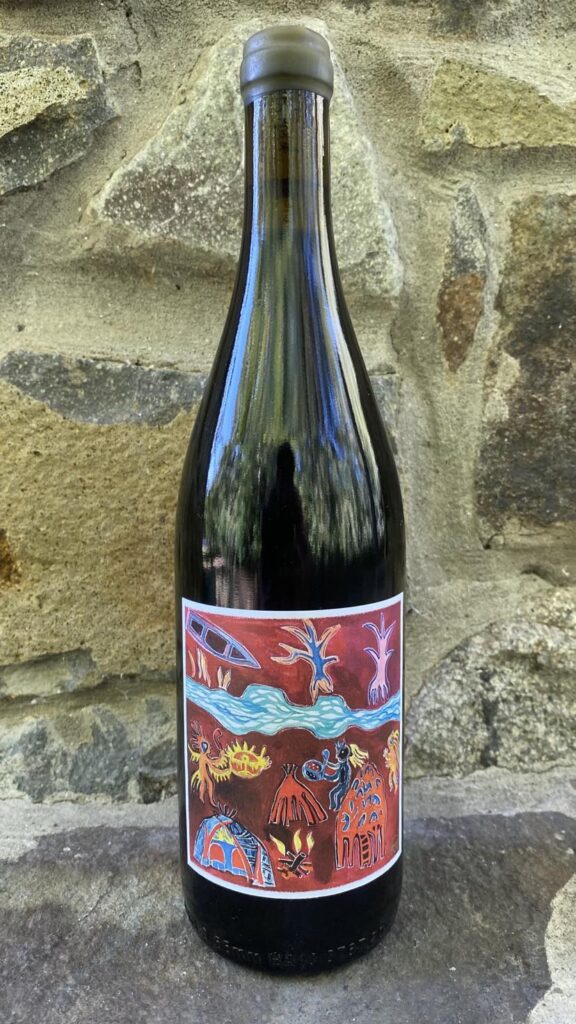
Hungarian conquest
During his sojourn in Lévedia, the Hungarian prince experienced a vivid dream. In this dream, massive eagles launched relentless attacks on his livestock, rending them asunder. The local populace attempted to fend off these predatory eagles, but their efforts proved futile, as the birds swiftly shifted their attacks elsewhere.
However, a courageous and swift turul, a mythological bird of prey highly revered in Hungarian and Turkic traditions and a symbol of Hungary, emerged on the scene. It swooped down from above and dispatched one of the eagles. Witnessing this, the remaining eagles retreated, prompting the Hungarians to contemplate relocation. They embarked on a journey to the land once ruled by Attila the Hun, passed down as a legacy. Yet, their path was unknown to them. It was then that the Turul reappeared, soaring above, and beckoned them to follow until it vanished from their sight.
Shortly after this dream, a pestilence befell their livestock, and a turul bird in flight kicked one of the vultures scavenging the lifeless remains. Recognizing the correlation between this incident and the dream, all the Hungarians gathered around and followed the Turul’s lead. Wherever the bird disappeared from view, they established their camps. The Turul reappeared periodically, and the Hungarians faithfully followed, eventually arriving in Pannonia, the former realm of Attila. There, the Turul vanished from their sight once and for all, prompting them to settle in this new land.
Siller Zweigelt 2021 12,5% dry unfiltered
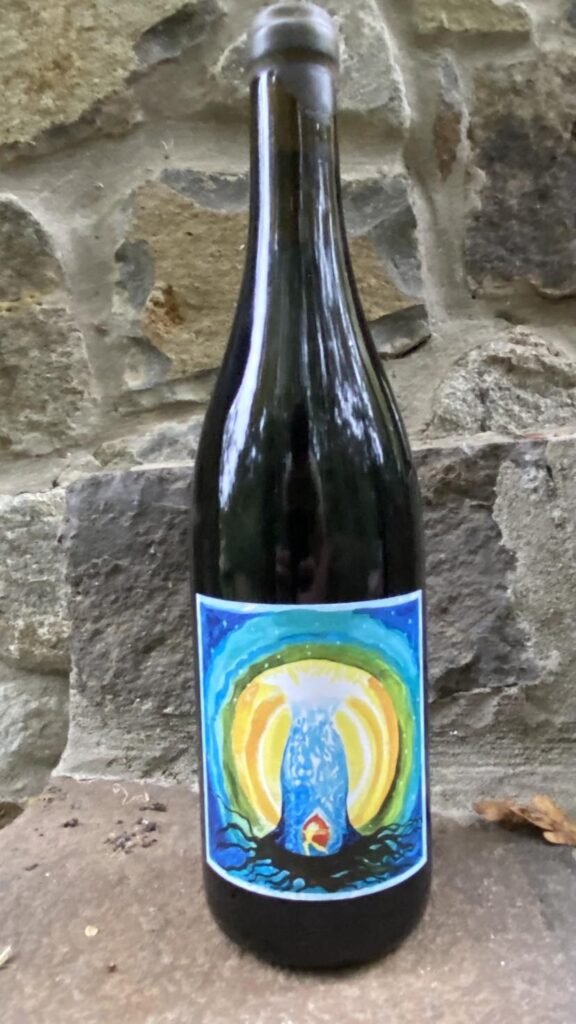
Son of the White Mare I
This tale hails from an ancient era when humanity did not seek dominion over nature but instead embraced a profound sense of unity with it. It reflects an awareness of nature that perpetuated a worldview rooted in faith, predating the rise of Christianity.
“Son of the White Mare” (Hungarian: “Fehérló fia”) stands as one of the most ancient and enduring Hungarian legends. Its narrative, characters, and symbols draw their origins from the rich folklore of the Hun, Avar, and Hungarian peoples. The horse, in this context, symbolizes the equestrian cultures of the desert and serves as a bridge between the Earth and the Heavens.
Within the narrative:
The White Horse is a miraculous mare, an embodiment of celestial purity and the terrestrial manifestation of heavenly forces, akin to the Sun.
This horse, in its form, carries the essence of the Earth. It gives birth to a human boy and nourishes him with its milk, imparting its power unto him. For seven years, she nurses the boy, and as he grows in strength, the White Horse’s power diminishes.
In the seventh year, the White Horse instructs her son to climb a towering tree and strip its bark. However, the boy finds himself unable to complete this task. The mare then nurses him for an additional seven years (in some versions, three times for seven years). When the boy successfully peels the bark from the largest tree, the White Horse transfers her strength to him and passes away. As the boy ascends the tree, reaching towards the sky, he gains access to celestial energies. The White Horse fulfills her mission: she bestows her power, her physical form returns to the earth, and her soul ascends to the heavens.
Rosé Kékfrankos 2021 12% dry unfiltered

Son of the White Mare II
The Son of the white mare (Fehérlófia) set out on a journey to explore the world, which began in a dense forest that mirrored the density of life’s challenges. In this deep forest, he encountered an exceptionally strong man who effortlessly uprooted trees from the ground with his bare hands. This man was Fanyűvő, who had long awaited a confrontation with Fehérlófia. However, Fehérlófia wasted no time and immediately engaged in the battle, using his astonishing strength to defeat Fanyűvő. Consequently, Fanyűvő was compelled to serve Fehérlófia, and they continued their journey together.
As they ventured further through the forest, they suddenly came across a man who crushed stones with such ease, as if they were mere pieces of bread. He too challenged Fehérlófia, but ultimately succumbed, joining Fehérlófia as a servant.
Their third encounter was with Vasgyúró, who effortlessly molded iron as one would knead dough. However, Fehérlófia once again demonstrated his strength and defeated Vasgyúró. Thus, Vasgyúró also became a part of their entourage.
These three incredibly powerful beings symbolized not only strength but also endurance and resilience, reflecting the hierarchy of the steppe peoples in this particular order. Since Fehérlófia had obtained his strength from the magical Fehérló, he easily surpassed them, and they all served him. The horse, as introduced in their initial encounter, represented not only strength but also endurance and resilience, especially among equestrian peoples.
.
Kövidinka 2021 orange 12% dry unfiltered
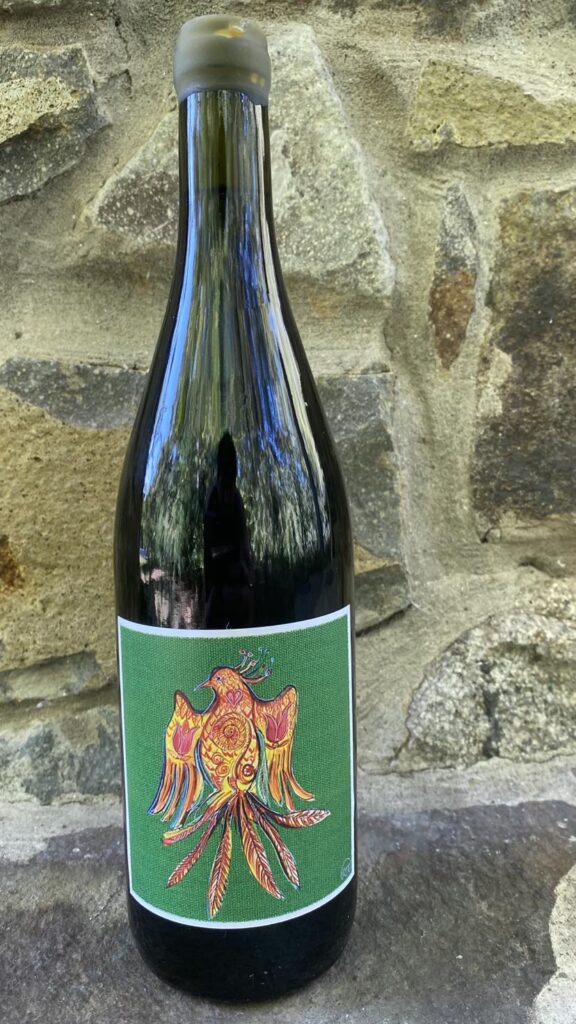
Legend of Tüzmadár
In a remote village, surrounded by dense forests and majestic mountains, there existed an ancient legend of the Tüzmadár – the Firebird. This bird, as the tale went, possessed plumage of flaming red and could breathe fire, which bestowed life and rejuvenated nature.
The villagers revered the Tüzmadár as a symbol of hope and life. In dry years when the fields withered, and the streams ran dry, they prayed to this legendary bird, hoping for its appearance.
One scorching summer, when the earth was parched and dry, and the villagers were in despair, the miracle happened. In the blazing midday sun, the Tüzmadár appeared in the sky. Its plumage gleamed in a dazzling red as it gracefully hovered in the air. With a resounding call, it breathed fire onto the arid land.
The flames of the Tüzmadár transformed into gentle rain, irrigating the fields and reviving nature. Grasses shot up, flowers blossomed, and the streams began to flow once more. The villagers rejoiced in joy and gratitude for this divine gift.
The Tüzmadár returned time and again when nature needed its help, becoming a symbol of community and unity. The people in the village learned to respect and protect nature, and the legend of the Tüzmadár was passed down from generation to generation.
To this day, people in this village tell the story of the Tüzmadár and keep alive the traditions and customs associated with this powerful legend. The Firebird remains a symbol of hope and wonder in their hearts, reminding them that in dark times, the light of community and the power of nature can rejuvenate them time to time again.
Kékfrankos rosé Pet Nat 2021 11,5% half dry unfiltered
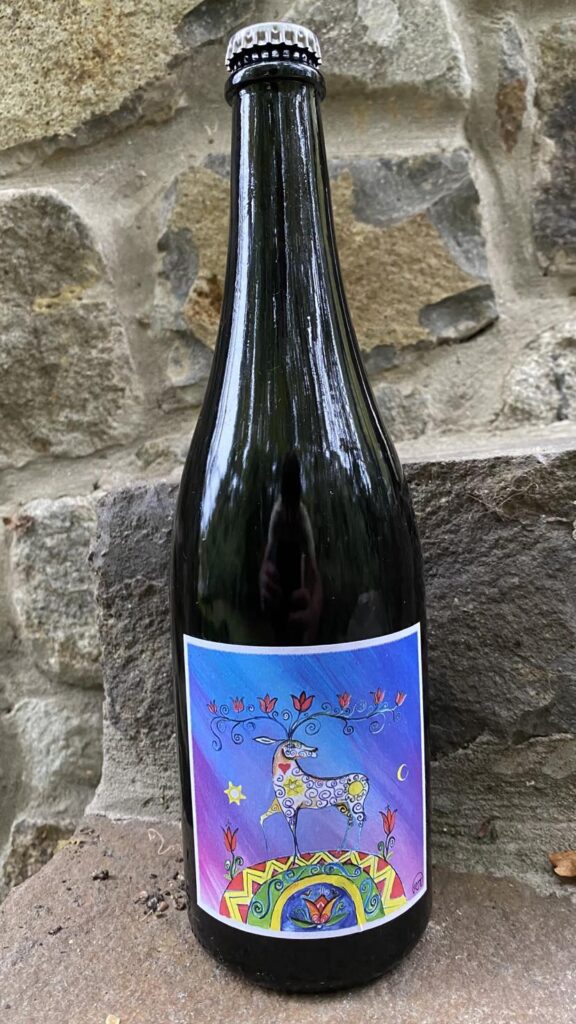
Legend of CsodaszArvas
In a remote and idyllic region of Hungary, where dense forests and clear rivers defined the landscape, the legend of Csodaszarvas, the Miracle Deer, flourished. This majestic creature was considered the guardian of the forest and a symbol of the connection between the natural world and the spiritual realm.
The tale of Csodaszarvas began long ago when people in this region were deeply connected to nature. A young hunter named Márton was known for his humility and respect for the animal kingdom. One day, he ventured alone into the woods to gather food for his family.
As Márton moved quietly through the forest, he stumbled upon a magnificent doe, Csodaszarvas. Its fur glistened in the rays of the rising sun, and its eyes seemed to hold the secret of life itself. Yet, Márton, who was not a hunter in the conventional sense, hesitated. He recognized the uniqueness of this creature and bowed in reverence before it.
Csodaszarvas, sensing Márton’s sincere reverence, lowered its head and gently touched Márton’s forehead. In that moment, Márton felt a surge of enlightenment and a deep connection with nature. He understood that the forest and its inhabitants were a precious gift to be protected.
Márton returned to his community and shared his encounter with Csodaszarvas. He spoke of the wisdom and beauty of this being and his own enlightenment in the woods. The people were profoundly moved by his story and decided to honor and protect the forest and its inhabitants.
The legend of Csodaszarvas spread throughout the region, and soon customs and rituals were developed to strengthen the bond between humans and nature. People learned to live in harmony with the environment, and the forest thrived, while the animals lived in peace and safety.
Csodaszarvas became a symbol of nature’s wisdom and the necessity of respect and gratitude towards our environment. This legend taught people that the true beauty of the world lies in its natural splendor and that it is our duty to preserve and protect it so that future generations can experience it. And so, the story of Csodaszarvas lived on in the hearts of people, as a reminder of the unity of humankind and nature.


